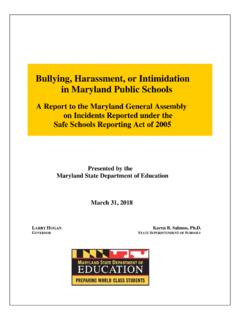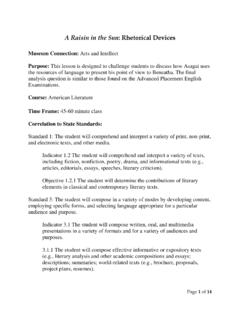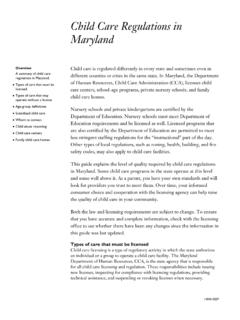Transcription of Code of Maryland Regulations (COMAR) 13A.05.02.04 State ...
1 TO: Members of the State Board of Education FROM: Karen B. Salmon, DATE: May 22, 2018 SUBJECT: code of Maryland Regulations (COMAR) State Administration ADOPTION _____ PURPOSE: Request permission to adopt additions to COMAR State Administration which will govern the identification of significant disproportionality under the Individuals with Disabilities Education Act (ATTACHMENT I). REGULATION PROMULGATION PROCESS: Under Maryland law, a State agency, such as the State Board, may propose a new or amended regulation whenever the circumstances arise to do so. After the State Board votes to propose such a regulation, the proposed regulation is sent to the Administrative, Executive, and Legislative Review (AELR) Committee for a 15-day review period.
2 If the AELR Committee does not hold up the proposed regulation for further review, it is published in the Maryland Register for a 30-day public comment period. At the end of the comment period, the Maryland State Department of Education (MSDE) staff reviews and summarizes the public comments. Thereafter, MSDE staff will present a recommendation to the State Board of Education to either: (1) adopt the regulation in the form it was proposed; or (2) revise the regulation and adopt it as final because the suggested revision is not a substantive change; or (3) revise the regulation and re-propose it because the suggested revision is a substantive change.
3 At any time during this process, the AELR Committee may stop the promulgation process and hold a hearing. Thereafter, it may recommend to the Governor that the regulation not be adopted as a final regulation or the AELR Committee may release the regulation for final adoption. BACKGROUND/HISTORICAL PERSPECTIVE: On December 12, 2016, the Department of Education released final Regulations under Part B of the Individuals with Disabilities Education Act (IDEA). The Regulations aimed to promote equity by addressing significant disproportionality in the identification, placement, and disciplinary removal of students with disabilities based on race or ethnicity.
4 Such reporting under the IDEA is not new, but the Regulations were revised to require that each State use a standard methodology (risk ratio) within reasonable data parameters (34 (b)). The revised federal requirements were set to become effective on July 1, 2018. 200 West Baltimore Street Baltimore, MD 21201 410-767-0100 410-333-6442 TTY/TDD Members of the State Board of Education May 22, 2018 Page 2 During the following year, the MSDE set out to define Maryland s process for identifying significant disproportionality, consistent with the revised federal requirements. This involved setting a risk ratio threshold, a minimum cell size no greater than 10, and a minimum n-size no greater than 30 (34 (b)).
5 It also involved a decision as to whether Maryland would exercise one or both flexibility options that are available. A State is not required to identify a local education agency (LEA) until it has exceeded the risk ratio threshold for up to three consecutive years (multi-year flexibility) and/or failed to demonstrate reasonable progress in lowering the risk ratio (reasonable progress flexibility) (34 (d)). Each of these decisions about the process for identifying significant disproportionality under the IDEA was incorporated into the proposed regulation. Identifying an LEA as having significant disproportionality under the IDEA continues to trigger certain consequences.
6 The LEA must review and revise its policies, practices, and procedures, if appropriate, and publicly report on the results of that process (34 (c)). At the same time, the LEA must reserve the maximum 15 percent of its Part B funds to provide comprehensive coordinated early intervening services (CEIS) to address factors contributing to the significant disproportionality (34 (d)). This occurs if significant disproportionality is identified in any of the applicable categories of analysis ( , identification, placement, and disciplinary removal). On December 5, 2017, the State Board approved the proposed regulation for publication.
7 It was published in the Maryland Register on March 30, 2018. During the 30-day public comment period, MSDE received one comment from Montgomery County Public Schools, which suggested using the minimum cell size (10) and minimum n-size (30) referenced in the federal regulation. These are the largest numbers that would still be presumed reasonable by the Department of Education. In addition, two public listening forums were held on April 24, 2018 and April 25, 2018 at public libraries in Frederick County and Anne Arundel County. MSDE received no comments at these forums. Ultimately, the proposed regulation was based on the advice of stakeholders, which MSDE solicited over the course of three meetings between April 2017 and July 2017, consistent with the revised federal requirements (34 (b)).
8 On February 27, 2018, the Department of Education released a Notice of Proposed Rulemaking, in which it proposed postponing the compliance date of its final Regulations by two years, from July 1, 2018, to July 1, The proposal was open for public comment until May 14, 2018. As of this writing, the Department of Education has not yet adopted its proposal as final. The Notice of Proposed Rulemaking acknowledged that some states that may already be prepared, or nearly prepared, to implement the Regulations on July 1, 2018, will continue to do so, regardless of any delay in the compliance date. Maryland is one such State .
9 EXECUTIVE SUMMARY: MSDE proposes the following process for identifying significant disproportionality under IDEA: Risk Ratio Threshold = (if a LEA has a risk ratio above this number, it may be identified as having significant disproportionality) 1 If the compliance date is postponed until July 1, 2020, it will also delay inclusion of children ages 3-5 in the calculation of significant disproportionality in the area of identification until July 1, 2022. MSDE is planning to include this population of children on July 1, 2018, regardless of whether the compliance date is postponed. Members of the State Board of Education May 22, 2018 Page 3 Minimum Cell Size = 5 (this is the numerator in the calculation; if a LEA has fewer than 5 instances of the measured action, then it is excluded from analysis) Minimum N-Size = 20 (this is the denominator in the calculation.)
10 If a LEA has fewer than 20 students in a racial/ethnic group, then it is excluded from the analysis) Reasonable Progress = for risk ratios and for risk ratios above (this is a two-step analysis whereby a LEA is not identified unless it has exceeded the risk ratio for two consecutive years; if it has, then it still may not be identified if it has shown progress in decreasing the risk ratio by these numbers) The proposed regulation would adhere to the original effective date of July 1, 2018, regardless of whether the Department of Education decides to postpone the compliance date. ACTION: Request permission to adopt the additions to COMAR State Administration.



















